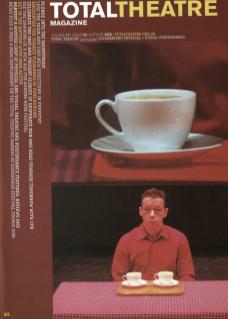It's always a cause for celebration when an organisation ventures out of its safety zone to present new work. Such was the case when the Chelsea Theatre took another step away from its formerly play-centred programming to produce its Live 05 season of live art, featuring three months of work from seventeen different companies and representing a wide spectrum of contemporary performance.
I confess to being nervous when I saw the banner outside the Chelsea reading ‘Live Art – Theatre's Future?'. The season kicked off with a panel discussion on live art chaired by Guardian theatre critic Lyn Gardner and featuring, amongst others, members of some of the contributing companies, an Arts Council representative, and (inexplicably) the literary manager of the National Theatre. The Chelsea's history showed from the start, as the discussion was framed in terms of 'story' and, there it was again, the ‘future of theatre'. It was Exit Strategy's Theron Schmidt who punctured a slightly self-congratulatory mood by noting from the audience that, if live art is the future of theatre, 'why are we at the Chelsea and not the National?' As the panel haltingly began to address live art in terms other than theatrical, some of the practitioners involved (Robert Pacitti, Vicki Arbuckle) were able to nudge things along and the discussion managed – barely – to avoid asking just what is live art, anyway?
Which brings us back to the banner. Live Art – Theatre's Future? Well, no. If anything, it is theatre's past which helped birth live art; the inability of the conventions of traditional performance to accommodate the new time and body based explorations of the performance artists who rejected object-based fine art and its associated commercial context. I had high expectations from an organisation supporting the excellent ROAR experimental theatre season, but with a misapprehension writ large outside and the launch event asking the wrong questions, I was worried about what the Chelsea had in store. Even the original call for artists emphasised fractured narratives (story, again) and 'an aesthetic likely to utilise new technology’ (Techno-gimmickry – Theatre's Future?).
It turns out I needn't have worried. The Chelsea is finding its feet in the uneven terrain of live art, and these few minor missteps are perhaps indicative of an organisation in transition. With its website still offering audiences 'exciting plays in friendly and comfortable surroundings’ the Chelsea is turning its attention to previously unexplored territory. Artistic Director Francis Alexander assembled an impressive range of artists and should be congratulated for his efforts. Featuring both old hands (1157 Performance Group ticking the technology box, Third Angel with their charming, if a little lightweight Hurrysickness) and emerging companies (The Society of Wonders, Demonstrate). Live 05 was a brilliant opportunity to sample a wide variety of new performance.
Alexander, now cultivating relationships across the live art sector, said he was pleased with the diversity and scale of the season. He found Live 05 'rewarding and tantalising... [we have] only scratched the surface', and promised much more live art at the Chelsea in the future. He was particularly excited that some of the Chelsea's traditional audience crossed over to test the live art waters. Attendance across the season seemed to vary considerably... perhaps inevitable with a large programme, or perhaps a reflection of the Chelsea's own uncertainty as to what they were presenting.
It's encouraging to see an organisation challenge itself to embrace new work and I am excited to see what Alexander and the Chelsea present next. I just hope Live 06 has a different banner out front.
Seth Kriebel is the artistic director of Rules and Regs and a contributor to Live 05 participating company Sidelong.

